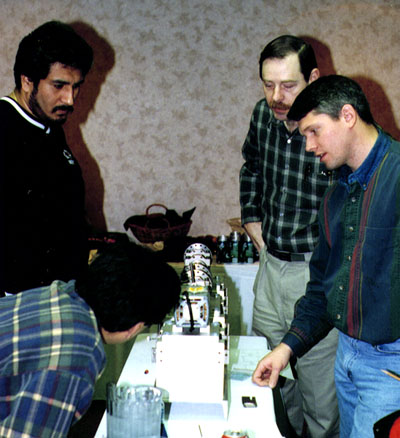Basic / Level 1 - Shaft Alignment Training Course

The two day Basic Alignment course and the three day Level 1 Certification Preparatory course are designed to train students ranging from those who have little or marginal experience in shaft alignment up to people who have been doing alignment for years but ... have not been exposed to all of the different dial indicator alignment methods, have not understood how to check or correct a 'soft foot' condition, have never used the alignment graphical/modeling technique, and would like to know about the advantages and disadvantages of all of the available alignment systems on the market today.
It is an excellent course for...
- Plant, maintenance, and production managers (who frequently do not understand why alignment takes longer than 45 minutes)
- Plant, maintenance, and production engineers (who were never taught this in school and are rarely allowed to do hands-on work)
- Technicians (who are asked to identify it through vibration analysis but may not know how to correct it)
- Trades personnel (who are the ones ultimately responsible for the final outcome) to give them the minimum working knowledge to achieve accurate alignment on two element drive systems (e.g. a motor and a pump) and to let them know what is involved in the overall alignment process.
The students in the Basic/Level 1 course will learn about the importance of alignment, how to: correct soft foot, check runout, align two pieces of rotating machinery using dial indicators, and to review all the currently used alignment equipment and techniques (e.g. lasers and electromechanical systems).
Material from other courses on vibration analysis and antifriction bearings are usually interjected to supplement the course and assist the students in understanding how alignment affects overall machinery performance.
Recommended background knowledge for basic alignment course...
- basic understanding of rotating machinery such as : motors, pumps, gears, compressors, fans, etc.
- have seen someone do alignment, have tried it themselves, or have heard what alignment is
Each student that attends the 2 day Basic course receives a copy of the Basic Shaft Alignment Workbook and a certificate of completion. Each student that attends 3 day Level 1 Certification Preparatory course receives a copy of the Basic Shaft Alignment Workbook, a copy of the Shaft Alignment Self Study Guide, and a certificate of completion.
Course Objectives
The Basic or Level 1 Certification Preparatory Shaft Alignment Training Course is a lecture and lab workshop where the students will be doing hands-on work with machinery alignment demonstrators. After completing this course, the students will...
- be able to recognize the symptoms of misaligned rotating machinery
- understand how shaft misalignment causes failures in equipment such as: motors, pumps, gears, turbines, fans, compressors, and other types of rotating machinery
- have a clear definition of shaft misalignment and how to quantify the amount of misalignment to determine if machinery is within acceptable tolerance limits
- possess a step-by-step procedure to guide them through the alignment process
- have a sense of approximately how much time each step of the alignment process requires
- understand how to measure runout on mechanical couplings and machinery shafts
- recognize different kinds of faults that cause excessive runout conditions and understand when the problem is severe enough to warrant correction
- be able to measure and correct machine case to baseplate interface problems such as soft foot conditions that distort machine casings and shift the position of rotating machinery shafts when torquing down the foot bolts
- practice measuring runout on alignment demonstrators
- practice measuring and correcting soft foot problems on alignment demonstrators
- see how three commonly used shaft position measurement techniques are performed : the face-peripheral, reverse indicator, and shaft to coupling spool methods
- be able to measure bracket sag and adjust the shaft positions measurement readings taken from dial indicators to compensate for this phenomena
- practice the reverse indicator shaft position dial indicator measurement technique on alignment demonstrators
- learn how to plot the positions of machinery shafts onto scaled graphs using data from the reverse dial indicator method to easily visualize the vertical and lateral positions of the machinery
- be able to determine a variety of possible realignment solutions from the graph to best suit the specific conditions encountered on different machinery designs and installations eliminating unnecessary tasks (such as grinding baseplates to lower machinery) thereby minimizing the amount of time required to align machinery
- practice moving machinery from calculations made using the graphing technique on the alignment demonstrators
- know how to adjust the graphing set up to plot readings from asymmetrical bracket arrangements
- understand the importance of adjusting the positions of the machinery to maintain proper vertical, lateral, and axial alignment
- learn about tools and techniques to control lateral movement of machinery
- understand how to maintain accurate records to determine if machinery is moving out of alignment over a period of time and if so, how to look for the cause of this movement
- be able to recognize and correct induced piping stress problems
- be given a review of the available alignment systems currently on the market that include laser, or electromechanical sensors and understand the advantages and disadvantages of each system and the approximate cost of these systems
- review new computer software programs specifically designed for shaft alignment
Course Pricing
North America (United States, Canada, Mexico)
2 day Basic Shaft Alignment Course - $9495.00 USD
3 day Level 1 Certification Preparatory Shaft Alignment Course - $16995.00 USD
International Pricing
(outside of North America)
2 day Basic shaft Alignment Course - $10995.00 USD
3 day Level 1 Certification Preparatory Shaft Alignment Course - $18995.00 USD
We will train up to 20 people in the course. None of the above prices include shipping, travel and living expenses (contact us for these estimated costs to your location) and the cost for the certification test(s) are not included in the cost of any course.
